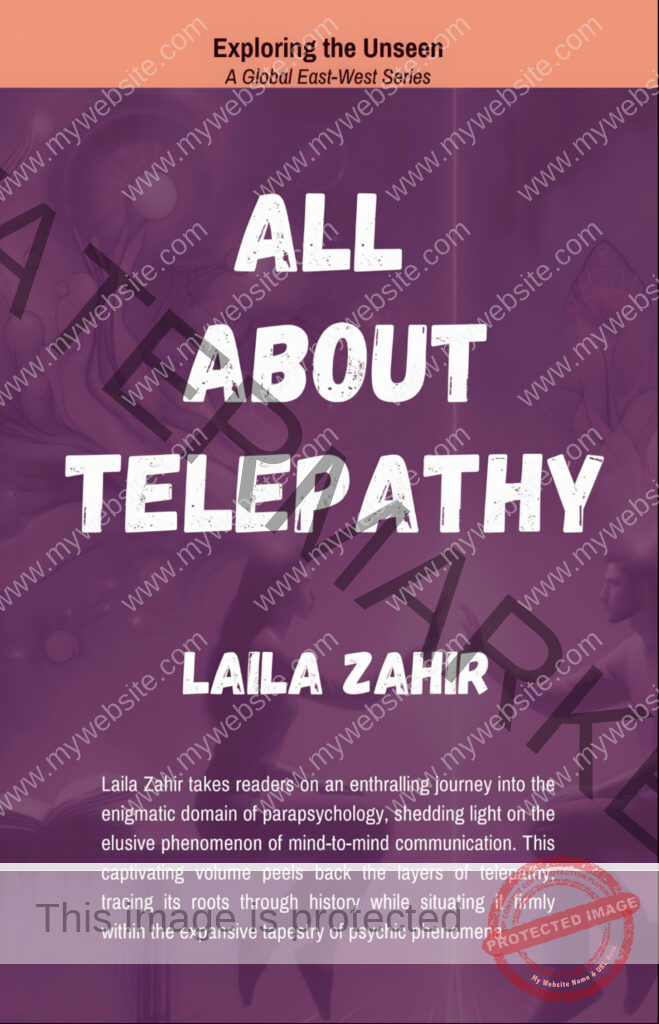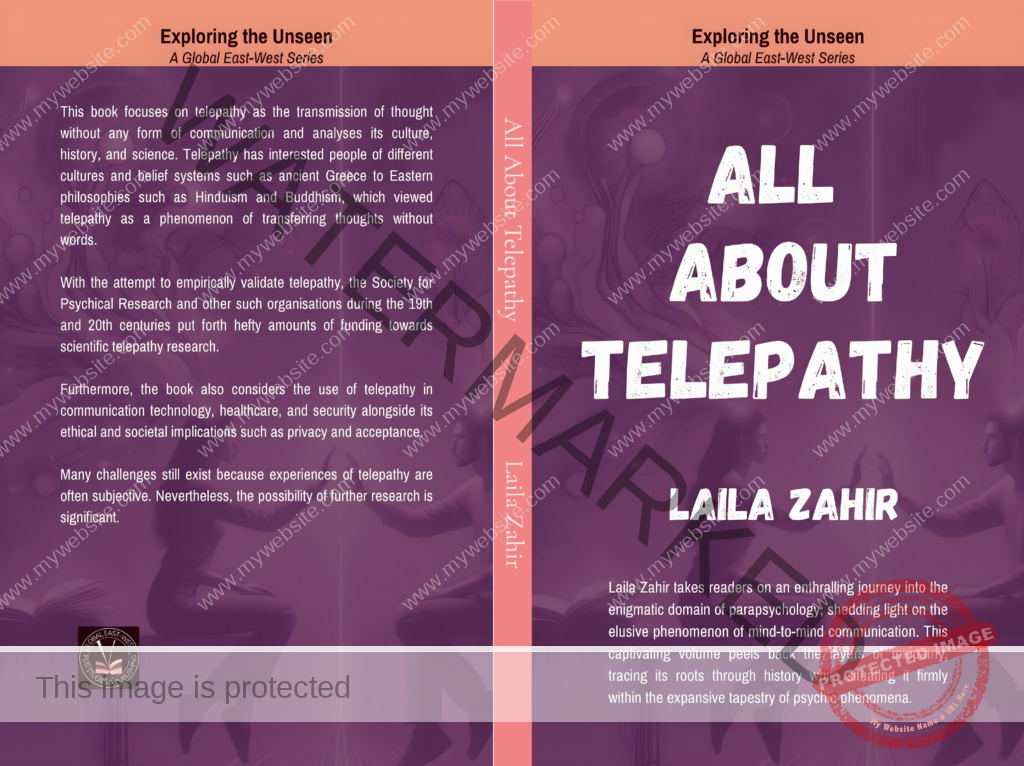All About Telepathy
Author: Laila Zahir
208 pages
5.5 x 8.5 in or 216 x 140 mm
In *All About Telepathy*, the second volume in the thought-provoking series *Exploring the Unseen*, author Laila Zahir takes readers on an enthralling journey into the enigmatic domain of parapsychology, shedding light on the elusive phenomenon of mind-to-mind communication. This captivating volume peels back the layers of telepathy, tracing its roots through history while situating it firmly within the expansive tapestry of psychic phenomena.
With meticulous precision, Zahir navigates through a wealth of information, compelling case reports, and experimental findings that collectively offer a glimpse into the mechanics underpinning telepathic connections. Her approach is both analytical and accessible, as she demystifies common myths and misconceptions while equipping readers with practical knowledge for nurturing their own latent psychic potential.
Blending scientific scrutiny with an engaging narrative style, *All About Telepathy* challenges conventional boundaries, beckoning readers to explore the profound possibilities of transcending verbal expression. Whether you are an adept practitioner seeking deeper insights or a curious sceptic dipping your toes into parapsychology for the first time, this book promises to be an indispensable companion on the quest to understand the untapped power of the human mind.
Table of Contents
Telepathy in Fiction vs. Reality
Role of Telepathy in Parapsychological Research
Risks and Dangers of Telepathy
Scientific Evidence and Research Challenges
Conclusion: The Future of Telepathy
Available on Amazon and Other Book Retailers
EXCERPT
Introduction to Telepath
Defining Telepathy
The word Telepathy is derived from the Greek language, with ‘tele’ meaning at a distance and ‘pathos’ explaining feeling or perception, alongside the alleged capability to transfer thoughts from one mental space to another without the use of recognised human senses or physical action. This particular phenomenon has baffled human understanding for ages, leading to great deliberations in scientific, philosophical and imaginable spaces. The concept of Telepathy has provided truth for some people and fiction for others, but it has intrigued half of the globe, leading to all kinds of interpretations and “Telepathy” frameworks. And while certain interpretations consider it a product of fiction and myth, others continue investigating the wider results of such exceptional… These two sides of the coin bring great controversy, which is something many people find fascinating. There are particular words and phrases that point to the transfer of thoughts from one person’s mind to another without words being exchanged, which leads to the use of ancient religious documents, fables and myths. Indeed, every age brought with it a different vocabulary to explain the art of Telepathy, showcasing the impressive chronic evolution of this phenomenon. Some people refer to this as mind reading, mental telegraphy or even ‘the use of thought woman’, which all point towards the need to explain and grasp the concept of Telepathy.
Today, Telepathy remains a fascinating topic that is integrated with conversations regarding extra-sensory perception and parapsychology. The idea of Telepathy continues to be fascinating and has led the scientific community to explore the depths of human communication further. While trying to define Telepathy, we must keep in mind the various cultural, spiritual and artistic interpretations surrounding it. Telepathy has been built and portrayed in literature, art, and even cinema, making it a vital part of pop culture. Even though the topic does surround controversy, it is important to note that Telepathy is a subject that deserves deeper analysis. While conducting the investigation, it becomes essential to note the historical narrative alongside the possibility of its existence within the complex web of human civilisation.
Historical Perspectives
The fascination regarding the concept of Telepathy intrigues humans regardless of the time period in question. The same can be said for multiple cultures and existing belief systems. The ability of thought transference has been deeply rooted in our existence, as depicted in ancient scripts and mythological stories where instances of telepathic communication have surfaced.
Great philosophers from ancient Greece, such as Aristotle and Plato, have wondered and explored the concept of communicating without the use of words and argued in favour of such a practice. The use of the word ‘telepathy’ stems directly from Greek, ‘tele’ meaning distance and ‘pathos’ meaning feeling or perception, indicating that the possibility of distant mental influence was present in classical times.
Much like the Western hemisphere, principles of Eastern civilisations such as Hinduism and Buddhism have and continue to endorse the idea of communication from one mind to another. Such venerable texts that derive from these religions express Telepathy as a universal method devoid of words where souls exchange thoughts without any boundary.
Focusing on the Middle Ages, our exploration of history reveals a plethora of alleged telepathic incidents solely based on mystical and spiritual narratives. Telepathy is believed by mystics and saints to be intertwined with divine solicitation, along with astonishing occurrences where direct thoughts can be transmitted.
After the Renaissance, people suddenly became more inquisitive about the undiscovered and the occult, which gave birth to the study of psychic phenomena such as Telepathy. Giordano Bruno and Paracelsus were prominent advocates of studying ‘occult virtues,’ a phenomenon through which Telepathy was argued to be one of its more rudimentary manifestations.
Telepathy became a juicy topic of scientific exploration during the 19th and 20th centuries, primarily with the introduction of psychical research alongside parapsychology. The aim of the Society established in 1882 for Psychical Research was to use empirical investigation to study Telepathy and other abnormal phenomena, moving away from overly speculative and anecdotal stories.
The historical perspectives discussed here dispel myths surrounding the global interest in telepathic abilities and elaborate on a more realistic approach with respect to cultural, philosophical, and scientific scope.
Cultural References and Beliefs
In Telepathy, we find a plethora of definitions, beliefs, and references from different cultures demonstrating humanity’s utter fascination with the idea of communication without a medium. The ancient civilisations of Greece, Egypt, and China all had stories and legends hinting at their understanding of Telepathy. The Indian Vedas, ancient sacred texts, broadly elaborate on the concept of Siddhis, which are supernatural abilities such as Telepathy, demonstrating its emphasis in early Indian culture.
In addition, tribes around the world have myths and stories surrounding telepathically engaging with others. For example, many Native Americans have a ‘silent language’ that enables them to transmit thoughts without verbal communication. African legends also talk about people who have the ability to communicate only by thinking, thereby not using any form of a shared spoken language.
In literature and arts, telepathic themes have made their way into the modern world, and they are not just confined to the regions of mythology. From the great plays by Shakespeare to contemporary science fiction stories, the idea of Telepathy has inspired many and captivated audiences. Telepathy, through the lenses of these cultures, is seen as an incredible gift as well as a means to foster deep and meaningful relationships.
Also, spiritual and religious beliefs are often found to overlap with Telepathy’s concepts. Prayer, meditation, and other forms of spiritual connections can be seen as an attempt to reach out at a mental level beyond the conventional oral or written way. The concept of Telepathy in these various religions stems from the ideals of empathy, kindness, and understanding.
While it may be the case that these cultural references provide an intriguing backdrop, it may also be true that we need to approach these cultural references with sensitivity and be aware of the impact of sociocultural dynamics and belief systems on the understanding of phenomena. These references contribute to the complex relationships between imagination, cultural contexts, and actual lived experiences that shape our understanding of Telepathy. As previously mentioned, these references are critical to understanding the extremes of sociocultural dynamics and their elements. Telepathy remains an interest to many, including academia and the average person. The scientific interest in Telepathy stems from one’s ability to communicate in a completely new manner and one’s ability to comprehend the human mind in a novel way. The scientific endeavour looks to demystify this fascinating phenomenon, even though cultural references and metaphors have created an unexplainable gravitational pull. Although there has been intense interest in imagining a world where metaphoric and actual borders of Telepathy can be radically altered for decades, scholars have battled with the endeavour of attempting to uncover the mountain of anecdotal data that surrounds legal supervision. The early endeavours of leading parapsychologists and psychologists driven by J. B. Rhine and Upton Sinclair, as well as Joseph Banks, have led to a revolutionary change, allowing a strong foundation in scholarship. These studies have provided tension to contemporary scholars for delving deeply into mental dialogue and metaphors that revolve around the sense of subordination.
In modern-day science, Telepathy is studied using a variety of methods, from experiments in a controlled laboratory environment to field trials. These studies utilise new technology, such as fMRI and EEG, to try to understand the brain processes related to Telepathy. Brain scientists, psychologists, and even quantum physicists contribute to the discussion around Telepathy, making it even more interdisciplinary.
Apart from statistical investigations, there is also a significant focus on theoretical modelling and computer simulations. Computational models and cognitive models attempt to devise plausible models that would enable telepathic communication within known paradigms of science. Many ideas from different areas are merged to reveal the possible ways through which Telepathy can be achieved and understood.
Despite the claim of the scientific community being filled with scepticism, Telepathy as a phenomenon has numerous possibilities of being proven with ongoing advancements in methodological rigour. The challenge continues to be refining the experimental and analytic strategies but still stands wide open to intrigue and investigation. It is also important to note that these challenges serve as motivation for exploration into the depths of the human consciousness and its capabilities.
Practical Relevance Today
Presently, Telepathy as a concept continues to intrigue large portions of people despite some believing it to exist solely in science fiction. Moreover, the concept proves to be incredibly useful within the modernised world we live in today due to its opening of new doors of possibilities. Perhaps the most eminent field, in my opinion, is communication technology. Telepathy, if proven or developed, allows people to directly exchange thoughts, concepts and ideas without the constraints of language or distances. Such phenomena would drastically alter interpersonal communication and foreign relations altogether.
In addition, Telepathy has the ability to change the healthcare industry. The ability to convey feelings, emotions, or urgent thoughts without using speech or written text can help patients greatly, especially those with physical disabilities or ailments that prevent normal expression. Lastly, Telepathy improves communication greatly, such as in the therapist-patient relationship. Psychologists would gain access to the thoughts and emotions of their patients and allow for an even greater understanding, which facilitates better interventions.
Furthermore, the consequences of Telepathy for security and defence appear deeply drastic. If used correctly, it could make information sharing more effortless and secretive for allies while avoiding interception from other nations, presenting a chance of confidentiality that exceeds our current means of encryption.
The advancement of telepathic communication can prove to be incredibly beneficial in the corporate world, too. Teamwork, negotiations, and decision-making can become more efficient and of better quality. Telepathy may also open doors in new fields of virtual reality and augmented reality by providing experiences far beyond the limits of current interface technology.
Like many other such predictions, those of Telepathy’s development were rather optimistic. Today, there are huge gaps between these predictions and reality. As was the case in the past, scientific validation and standards shape the face of any prevailing discipline, and equally so for this one. Most importantly, the integration of telepathic abilities into the presently established fabric of civilisation and legalities will, without question, bring about many challenges. Moreover, the degree of social readiness and degree of resistance to change, as well as the degree of available technology, compound the myriad of contradictions telepathy must overcome for real applicability in the current Society.
Challenges and Limitations
The research into Telepathy is challenging and has strong limitations. It needs to be noted that as intriguing as it seems, there are so many challenges that stand in the way of properly understanding it and utilising it. The most significant of these hurdles is the variable nature of telepathic experiences. Telepathy, unlike other forms of communication, appears to be wildly erratic and unstable. This makes it extremely difficult and even impossible to study and attempt to recreate telepathic phenomena in a convincing manner within the confines of a laboratory. Furthermore, the variations in personal perception that accompany telepathic interactions make it even more difficult to set the appropriate standards to attempt research and analysis. In fact, the biggest challenge one has to face is the lack of proof on a more tangible and objective basis. In principle, there is nothing apart from individual testimonies that can support the idea of Telepathy. These accounts can help highlight how real and tangible the phenomenon is, but at the same time, the absence of any quantifiable evidence makes the proof of Telepathy unfounded. Relying solely on subjective accounts opens the door to strong exclusion and doubt, especially among academic scholars and scientists.
Additionally, the ethics behind Telepathy create complicated issues pertaining to telepathic communication. The prospective breach of confidentiality and violation of individual freedom requires careful ethical deliberation. In the absence of such dilemmas and safeguards, the employment of telepathic skills might give rise to social and ethical problems. Furthermore, prejudices and differentiation against Telepathy impede its wider acceptance and credibility. The deep-seated doubts and resistance rooted in biased conventional thinking constitute major hurdles toward the consideration of Telepathy as a genuine area of inquiry. Overcoming such deep-seated biases and social perspectives will require not only robust scientific substantiation but also substantial public education and outreach.
Ultimately, the seemingly unattainable nature of Telepathy has drawn a great deal of scepticism and detailed evaluation from free thinkers of the world. For a great deal of time, the absence of definite mechanisms and a strong theoretical basis placed it in the realm of pseudoscience. Trying to find a solution for the vast gap that exists between observation and theory is certainly a huge problem. Solving these problems will require input from a range of disciplines, counter projects for collaborative research, and an extensive exchange of ideas spanning the ethics as well as the scientific areas. In so doing and addressing the problems that Telepathy brings, it can serve as an impetus for deeper and wider analysis of this unique human possibility.
Ethical Considerations
Having the ability to withhold powerful forms of communication, such as Telepathy, raises clear ethical issues. Issues range from the capacity to send thoughts without permission to influencing the recipient’s free will. Developing ethical boundaries will make it easier to steer through socially sensitive areas.
The ethical dilemma regarding the use of Telepathy is epistemic at best and procedural at worst. To what degree can the power to influence or rather control thoughts be juxtaposed with free will and moral oughtness? Telepathy, if put into the wrong hands, can lead to misuse and thus, ethical dilemmas necessitating the formulation of boundaries and policies arise.
Furthermore, the potential of Telepathy poses extreme risks in terms of privacy and the preservation of trust in individual relationships, workspaces, and Society at large. The question of how individuals may guard their mental privacy against real telepaths acquires the utmost significance.
In the simplest of terms, the ethical parameters surrounding telepathy call for extreme self-reflection and self-discipline as to how such abilities should be put into practice, if at all, and its repercussions. It further brings to the fore the need for respectful engagement, dialogue, and cooperation between various parties and the development of strong protective policies that promote ethical conduct and ensure respect for all.
Ensuring ethical standards around telepathic knowledge and insights always remains a significant portion of decision-making processes, not only today but in the future as well. Globally, developments in Telepathy are required to be advanced in a manner that ensures the safety of humanity as well, which is what makes considering these ethical dimensions important in the first place.
Myths and misconceptions around Telepathy need to be dismantled instead of treated as mere fantasies. It is far more complex than what is showcased in science fiction movies. More and more research has been conducted in hopes of proving the practicality of Telepathy, which breaks the barriers to how it is perceived in academics and science.
Another reason why there is a lack of differentiation between reality and fiction is the widespread notion that Telepathy allows humans to interpret anyone’s thoughts without any restrictions. While this isn’t closer to the truth, it does raise the probability of cracked communication being influenced by emotional states, environmental distractions and cognitive processes.
The telepathy gaps in films and books have taught the public that reality is far from perfect. Even so, the examination of scientific research and personal accounts claims that Telepathy could indeed work, but perhaps in a way that is more practical than one may think. This raises some important questions: how was communication done without speaking? What could Telepathy mean for the future? While these questions are pondered, one sets the foundation to build a more complex definition of Telepathy in his/her reasoning and tries to understand its true boundaries.
The recent growth in the world of telepathy studies has led both scientists and technology experts to come together to uncover the details of this phenomenon in order to better understand it. Moreover, the combining of everything that has emerged from neuroscience, psychology, and quantum physics allows for a great understanding and exploration of the telepathic experience itself.
A focal point within this inquiry lies in the telepathic experience. Furthermore, potential neural correlates appear to be the answer towards the explanation of this phenomenon.
The groundbreaking work by parapsychologists, cognitive scientists, and physicists for the validation of Telepathy has given rise to novel experiments that leverage interdisciplinary collaboration. These types of research are usually based on strict experimental designs, precise statistical measurements, and cross-verified evaluations for validation. Such powerful tools as computational modelling and artificial intelligence are crucial for the analysis of multifaceted Telepathy and the identification of important correlations in vast arrays of data.
Equally interesting is the psychological and anthropological study of Telepathy. Scholars attempt to understand the nature of Telepathy and its effects on the quality of life and relationships using qualitative interviews, surveys, and participant observation. In addition, the study of non-local consciousness, altered states of consciousness, and the effects of Will on Telepathy could further enable the pens of modern researchers to gain new insights.
Regardless, it is important to recognise the inherent problems presented within the study of Telepathy. Issues of methodology, validity, and replication effects will always be a source of great concern and debate. Similarly, questions of ethics with respect to informed consent, confidentiality, and the appropriate knowledge of Telepathy and the systematic beliefs associated with it should always be of concern.
As the challenge of understanding Telepathy continues to evolve, there is an increasing consensus among scholars about the importance of serious theoretical considerations and interdisciplinary discussions at a nuanced level in order for this field to move forward in a meaningful way. Looking at the current situation of telepathic research, we gain information and pave the way for further studies which will begin to peel the layers of these obscure telepathic phenomena.
Resources and References
Academic Books and Papers
Amadou, R. (1954). La parapsychologie. Paris: Denoël.
Baptista, J., & Derakhshani, M. (2014). Beyond the coin toss: Examining Wiseman’s criticisms of parapsychology. Journal of Parapsychology.
Bem, D. J. (2011). Feeling the future: Experimental evidence for anomalous retroactive influences on cognition and affect. Washington, DC: American Psychological Association.
Braud, W. (2003). Distant mental influence: Its contributions to science, healing, and human interactions. Charlottesville, VA: Hampton Roads.
Cardeña, E. (2018). The experimental evidence for parapsychological phenomena. American Psychologist.
Cardeña, E., Palmer, J., & Marcusson-Clavertz, D. (2015). Parapsychology: A handbook for the 21st century. Jefferson, NC: McFarland & Company.
Carr, F. (1974). Telepathy: The evidence for psychological communication between minds. New York: Castle Books.
Dawson, G. (2004). The telepathy of the imagination. Journal of Psychological Issues in Organizational Culture.
Dean, G. (1966). Telepathy and medical psychology. New York: Stein and Day.
Dossey, L. (2013). One mind: How our individual mind is part of a greater consciousness and why it matters. Carlsbad, CA: Hay House.
Dunne, J. W. (1927). An experiment with time. London: A&C Black.
Feussner, C. (2019). Telepathy: Building a framework for future research. Proceedings of the Parapsychological Association.
French, C. C. (2010). Missing the target: Suggestion and critical thinking. The Skeptic.
Freeman, L. (2020). Telepathy: A critical study. Frontiers in Psychology.
Gordon, A. (2010). A history of telepathy research: From dogma to discovery. Psychical Research Journal.
Gurney, E., Myers, F. W. H., & Podmore, F. (1886). Phantasms of the living. London: Trübner.
Haraldsson, E., & Gissurarson, L. R. (2015). The Icelandic experiments: Investigating the hypothesis of telepathy. Journal of Parapsychology, 79(3), 259-278.
Hastings, E. C. (1970). Anecdotal evidence for telepathy: A review of 20 cases. European Journal of Parapsychology.
Honorton, C. (1985). Meta-analysis of psi ganzfeld research. Journal of Parapsychology.
Irwin, H. J. (2004). An introduction to parapsychology. Jefferson, NC: McFarland.
Janet, P. (1889). L’automatisme psychologique: Essai de psychologie expérimentale sur les formes inférieures de l’activité humaine. Paris: Félix Alcan.
Kamm, R. M. (1989). Interpersonal relationships and telepathy: A study of connections. New York: Westview Press.
Kelly, E. F., et al. (2006). Irreducible mind: Toward a psychology for the 21st century. New York: Rowman & Littlefield.
Lazarus, M. V. (2008). The science of telepathy: Research and theory. Journal of Scientific Exploration.
Lilly, J. C. (1972). The center of the cyclone: An autobiography of inner space. Garden City, NY: Anchor Press.
Mayer, E. L. (2007). Extraordinary knowing: Science, skepticism, and the inexplicable powers of the human mind. New York: Bantam Books.
Milton, J., & Wiseman, R. (1999). Does psi exist? Lack of replication of an anomalous process of information transfer. Psychological Bulletin, 125(4), 387-391.
Morris, R. L. (1987). Anomalous cognition: An overview of the research. Journal of the American Society for Psychical Research.
Myers, F. W. H. (1903). Human personality and its survival of bodily death. London: Longmans, Green, and Co.
Radin, D. (1997). The conscious universe: The scientific truth of psychic phenomena. San Francisco: HarperEdge.
Radin, D. (2018). Real magic: Ancient wisdom, modern science, and a guide to the secret power of the universe. Harmony Books.
Rhine, J. B. (1934). Extra-sensory perception. New York: Henry Holt and Company.
Rhine, J. B. (1937). New frontiers of the mind: The story of the Duke experiments. New York: Farrar & Rinehart.
Schwartz, G. E. (2002). The afterlife experiments: Breakthrough scientific evidence of life after death. Atria Books.
Sheldrake, R. (2003). The sense of being stared at: And other aspects of the extended mind. London: Crown Publishers.
Sheldrake, R., & Smart, P. (2003). Experimental tests for telephone telepathy. Journal of the Society for Psychical Research, 67(3), 184-199.
Targ, R., & Puthoff, H. E. (1977). Mind-reach: Scientists look at psychic abilities. New York: E.P. Dutton.
Targ, R., & Puthoff, H. (2005). Mind-reach: Scientists look at psychic abilities. Hampton Roads Publishing.
Utts, J. (1991). Replication and meta-analysis in parapsychology. Statistical Science.
Windbridge Research Center. (2020). Contemporary evidence for telepathy: Published studies. Available from Windbridge Institute.
Zhang, X., & Tang, C. (2011). An experimental investigation of telepathy across distances. Journal of Consciousness Studies.
Articles and Journals
Alcock, J. E. (1990). Science and supernature: A critical appraisal of parapsychology. Prometheus Books.
Bradley, J. (2017). Telepathy: Reflections on a mysterious phenomenon. Journal of Consciousness Studies.
Bierman, D. J. (2003). Consciousness and time: Real evidence of non-local influences. Physica Scripta, 2003(2), 168–172.
Braud, W., & Andrews, P. (1998). Telepathy and the mind-matter problem. Journal of the Society for Psychical Research.
Cardena, E. (1994). Varieties of anomalous experiences: Examining the scientific evidence. Washington, DC: American Psychological Association.
Dawson, G. (2004). The telepathy of the imagination. Journal of Psychological Issues in Organizational Culture.
Feussner, C. (2019). Telepathy: Building a framework for future research. Proceedings of the Parapsychological Association.
Goswami, A. (1993). The self-aware universe: How consciousness creates the material world. New York: TarcherPerigee.
Haraldsson, E., & Gissurarson, L. R. (2015). The Icelandic experiments: Investigating the hypothesis of telepathy. Journal of Parapsychology, 79*(3), 259-278.
Hastings, E. C. (1970). Anecdotal evidence for telepathy: A review of 20 cases. European Journal of Parapsychology.
Irwin, H. J. (2004). An introduction to parapsychology. Jefferson, NC: McFarland.
James, W. (1896). Psychical research. The Psychological Review.
May, E. C., & Marwaha, S. B. (2018). The Star Gate archives: Reports of the US government sponsored psi program. McFarland & Company.
Mossbridge, J., & Radin, D. (2018). Precognition as a form of prospection: A review of the evidence. Psychology of Consciousness.
Parker, A., & Sjödén, B. (2010). The role of personal relationships in testing for telepathy. European Journal of Parapsychology, 25*(1), 111-125.
Roe, C. A. (2009). Psychological and parapsychological perspectives on non-local communication. European Journal of Parapsychology, 24*(2), 151-182.
Sheldrake, R., & Smart, P. (2003). Experimental tests for telephone telepathy. Journal of the Society for Psychical Research, 67(3), 184-199.
Shermer, M. (2011). The believing brain: From ghosts to gods and politics to conspiracies. New York: Times Books.
Storm, L., Tressoldi, P. E., & Di Risio, L. (2010). Meta-analysis of free-response studies, 1992–2008: Assessing the noise reduction model in parapsychology. Psychological Bulletin, 136(4), 471–485.
Tressoldi, P. E. (2011). Extraordinary claims require extraordinary evidence: The case of non-local perception, a classical and Bayesian review of evidence. Frontiers in Psychology, 2, 117.
Utts, J. (1991). Replication and meta-analysis in parapsychology. Statistical Science.
Walsh, R. (2003). The discovery of inner space: New research in the psychology of consciousness. New York: Wiley.
Wiseman, R. (2011). Paranormality: Why we see what isn’t there. Macmillan.
Wiseman, R., & Watt, C. (2004). The adverse effects of belief in the paranormal. Journal of the Society for Psychical Research, 68(3), 171–177.
Zingrone, N. L., Schlitz, M. J., Cardeña, E., & Krippner, S. (2013). Advances in parapsychological research 9. Jefferson, NC: McFarland & Company.
Critical Analysis
Alcock, J. E. (1990). Science and supernature: A critical appraisal of parapsychology. Prometheus Books.
French, C. C. (2010). Missing the target: Suggestion and critical thinking. The Skeptic.
Shermer, M. (2011). The believing brain: From ghosts to gods and politics to conspiracies. New York: Times Books.
Wiseman, R. (2011). Paranormality: Why we see what isn’t there. Macmillan.
Historical Works
Dunne, J. W. (1927). An experiment with time. London: A&C Black.
James, W. (1896). Psychical research. The Psychological Review.
Myers, F. W. H. (1903). Human personality and its survival of bodily death. London: Longmans, Green, and Co.
Podmore, F. (1894). Apparitions and thought-transference. Walter Scott.






MOST COMMENTED
Essais / GEW Intelligence Unit
Le monde au bord du gouffre: G7 et BRICS en quête de domination
Essais / Nos livres
La Chine, la Russie, les Etats Unis et Et L’avenir De La Géopolitique
Essais / Nos livres
Ambassadeurs de la technologie: Un pont entre les gouvernements et la technologie de pointe
Essais / Nos livres
Le pouvoir des petits États: La diplomatie dans l’arène mondiale
Essais / Nos livres
Naviguer dans l’incertitude: L’avenir de la gouvernance et de l’influence mondiales
Book Release / Essays / Exploring The Unseen / Our Books
All About Telepathy (EXCERPT)
Book Release / Diplomacy / GEW Essays / GEW Intelligence Unit
“Masters of Realpolitik: Pioneers and Practitioners”